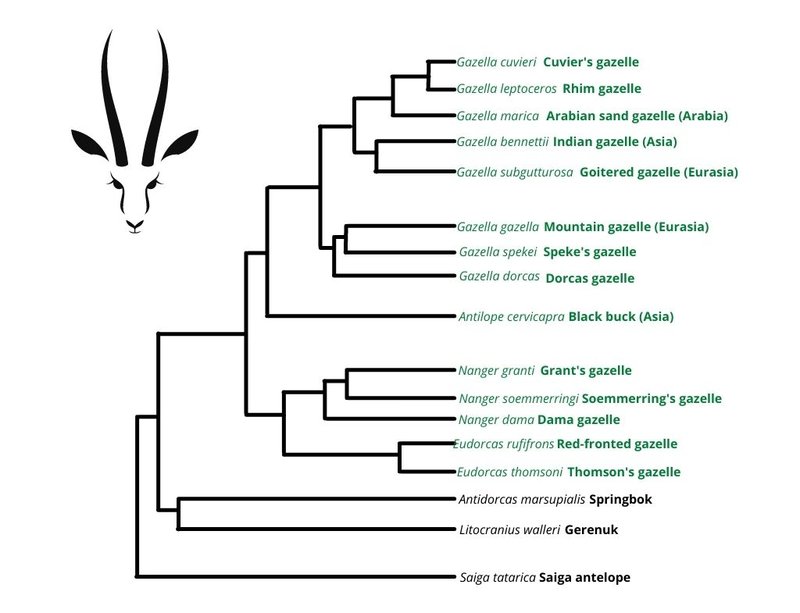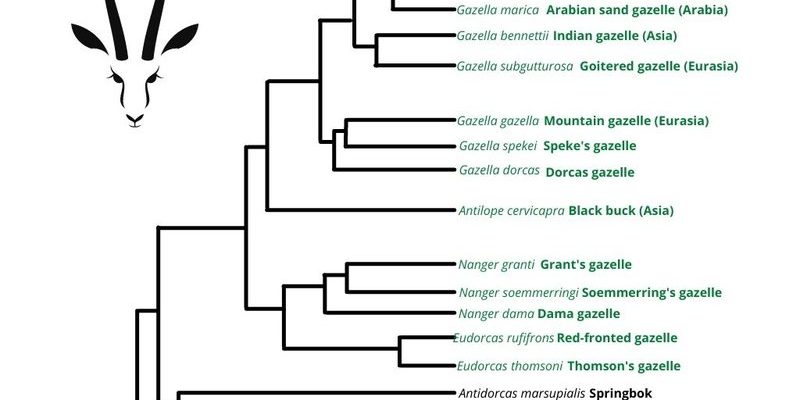
You might be surprised to learn that gazelles are not just one type of animal. They belong to a larger family called Bovidae, which includes species like antelopes, bison, and sheep. Gazelles have evolved in a way that highlights their unique adaptations to survive in various landscapes. So, grab a cup of coffee, and let’s dive deeper into this incredible story of evolution!
Understanding the Gazelle’s Family Tree
To appreciate the evolution of gazelles, it’s essential to understand where they fit into the animal kingdom. Gazelles belong to the family Bovidae, which is quite large and diverse. This family includes not just gazelles, but also antelopes, buffalo, and goats. Within this family, gazelles are part of the subfamily Antilopinae, which encompasses several species known for their slender bodies and high-speed running.
The earliest ancestors of modern gazelles appeared millions of years ago during the Miocene epoch, around 23 million years ago. During this time, the Earth’s climate was changing, leading to the development of open grasslands. Gazelles adapted to these habitats, evolving traits that allowed them to thrive in such environments. Their long legs and lightweight bodies made them exceptional sprinters, perfect for escaping from predators.
You might be wondering how scientists know about the gazelle’s ancient family history. Fossils play a crucial role in this understanding. By studying skeletal remains, researchers can analyze the physical characteristics that link ancient species to modern gazelles. For example, fossils of Gazella, a genus of modern gazelles, provide insights into the physical adaptations that have allowed these animals to survive and flourish.
Physical Adaptations for Survival
Gazelles are famous for their speed, capable of running up to 50 miles per hour! This remarkable ability stems from several key physical adaptations. First and foremost, they have long, strong legs that provide the necessary power for sprinting. Their slender bodies help reduce air resistance when they run, making them even faster.
Another interesting adaptation is their unique way of moving. Gazelles are known for their bounding gait, which helps them cover ground quickly while also maintaining balance. When they run, they can leap gracefully over obstacles, like rocks or bushes, almost like a dancer leaping across the stage.
But it’s not just about speed. Gazelles also have keen senses, including sharp eyesight and hearing. These senses allow them to detect predators from a distance, giving them an early warning to flee when danger approaches. Their ability to stay alert and agile has been a significant factor in their survival, especially in the African savannah, where predators like lions and cheetahs are a constant threat.
Gazelle Species and Their Habitats
When discussing the evolutionary history of the gazelle, it’s essential to look at the different species and their unique adaptations to various habitats. There are several types of gazelles, each adapted to specific environments, including:
- Thomson’s Gazelle: Found in East Africa, this species is one of the most numerous and can be spotted in open savannahs.
- Grant’s Gazelle: Also native to East Africa, this gazelle prefers grasslands and is known for its impressive jumping ability.
- Dama Gazelle: Once widespread, this species now faces habitat loss and is critically endangered, mainly residing in North Africa.
Each species has evolved specific traits that enhance its survival in its unique habitat. For instance, Thomson’s gazelle has a light build and is incredibly swift, which helps it escape predators in the open savannahs where it lives. In contrast, the Dama gazelle is less agile but has developed other features, like a distinctive coloration, to blend into its surroundings and avoid detection.
Understanding the different gazelle species helps illustrate how evolution tailors animals to their environments. These adaptations are vital for their survival, impacting not just their physical traits but also their social behaviors and feeding habits.
The Role of Gazelles in Their Ecosystem
Gazelles play a crucial role in their ecosystems. As herbivores, they primarily feed on grasses, leaves, and shoots. This feeding habit helps maintain the balance in their habitats by controlling the growth of vegetation. By grazing on grass, they promote new growth, which benefits other animals in the ecosystem.
Moreover, gazelles often serve as prey for various predators, contributing to the food chain. Their presence supports the populations of larger carnivores, like lions and cheetahs, which rely on gazelles as a significant food source. In this way, gazelles not only survive but also help sustain the overall health of their ecosystems.
Another fun fact about gazelles is their social behavior. They often form groups, known as herds, to increase their chances of survival. Living in a herd allows them to keep a watchful eye for predators. When one gazelle spots danger, it alerts the others, ensuring the group remains safe.
Threats to Gazelle Populations
Despite their remarkable adaptations and roles in the ecosystem, gazelles face significant threats that have caused declines in their populations. One of the most pressing issues is habitat loss due to human activities, like agriculture and urban development. As humans expand their territories, they encroach on the natural habitats that gazelles depend on for survival.
Additionally, hunting poses a considerable threat to gazelles, especially in regions where poaching occurs. Some gazelle species are targeted for their meat or horns, contributing to their dwindling populations. The Dama gazelle, for example, is now critically endangered due to a combination of habitat loss and hunting.
Conservation efforts are underway to protect gazelle populations and their habitats. Many organizations work to create protected areas, raise awareness about the importance of these animals, and support sustainable practices that benefit both wildlife and local communities. It’s crucial for us to understand the challenges facing gazelles so we can all play a part in their preservation.
The Future of Gazelles in the Wild
Looking ahead, the future of gazelles largely depends on how we address the threats they face. Efforts to conserve their habitats and protect them from poaching are vital for their survival. Innovative strategies, like community-based conservation programs, can help local populations coexist with gazelles, ensuring that both humans and wildlife benefit.
It’s important to remember that every species plays a unique role in the ecosystem. Gazelles, with their elegance and grace, contribute not just to the biodiversity of their habitats but also to the cultural heritage of the regions they inhabit. The beauty of gazelles continues to capture the hearts of people around the world, reminding us of the importance of preserving our natural world.
In conclusion, the evolutionary history of the gazelle is a captivating tale of adaptation and survival. From their ancient ancestors to the graceful animals we see today, these creatures showcase the remarkable impact of evolution over millions of years. Understanding their journey helps us appreciate their significance in the ecosystem and highlights the need for continued conservation efforts. So, the next time you see a gazelle bounding across the plains, remember the incredible history that has shaped it into the stunning animal it is today.

